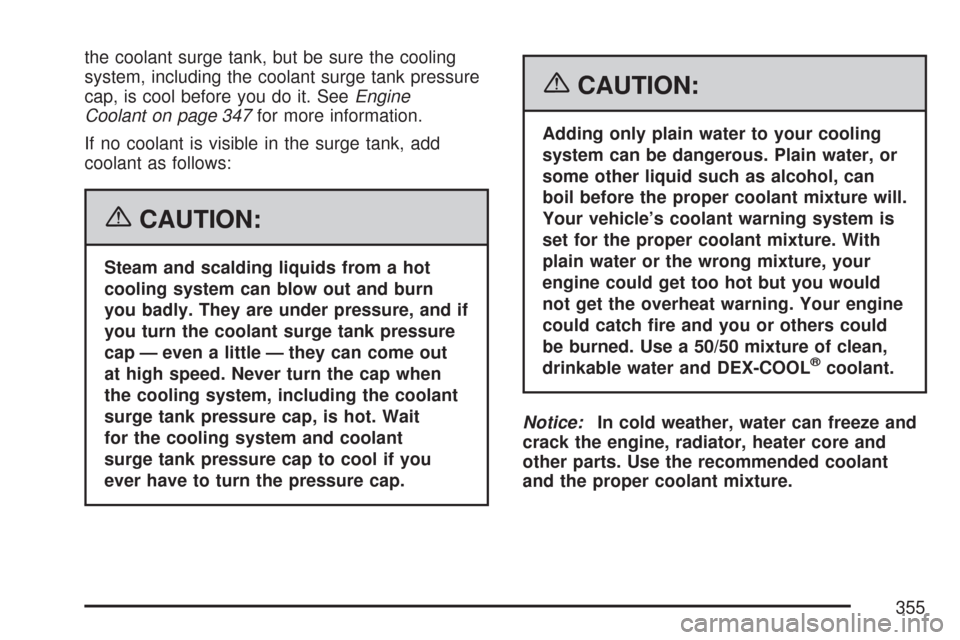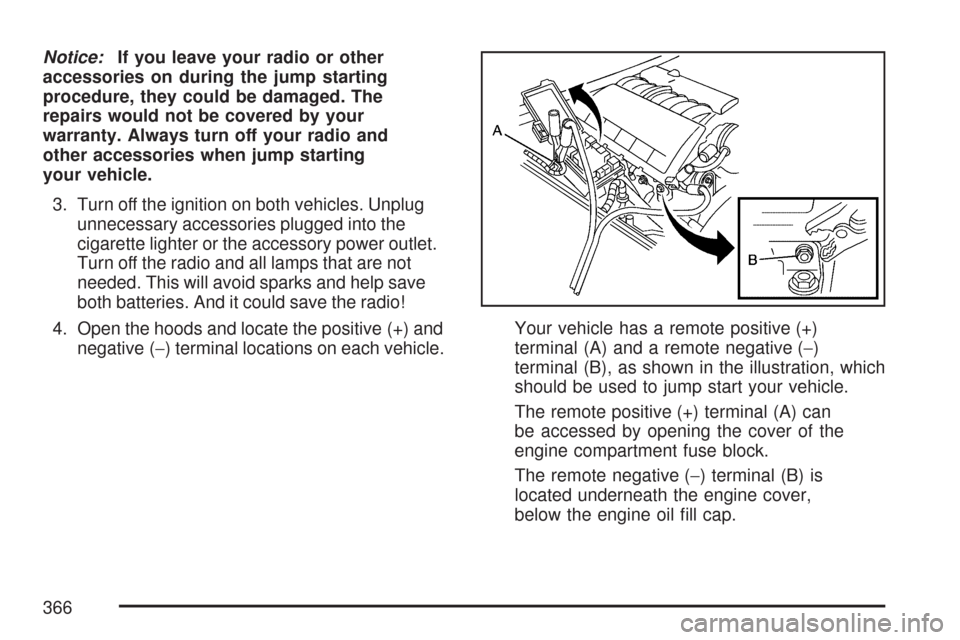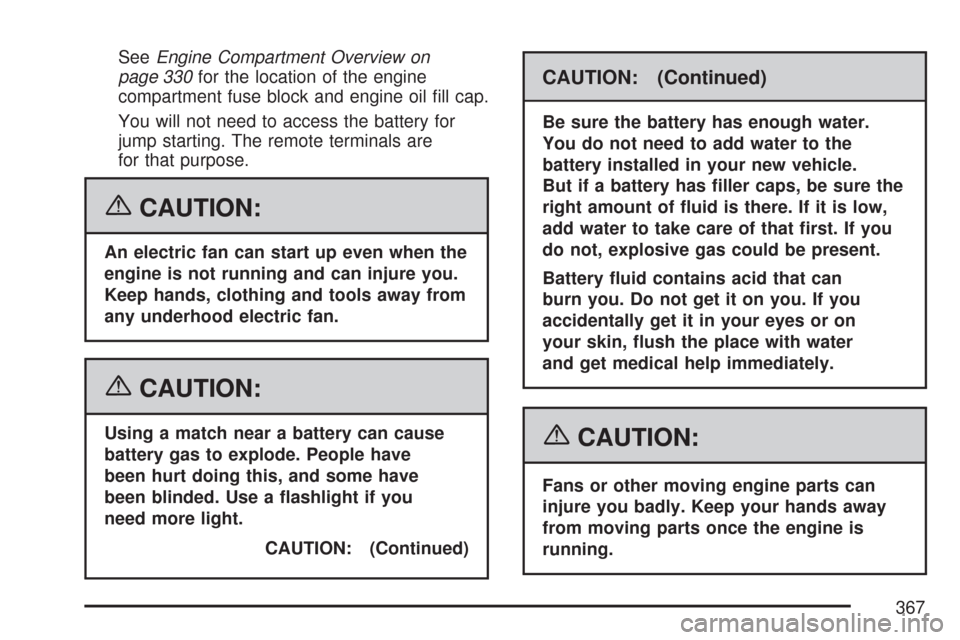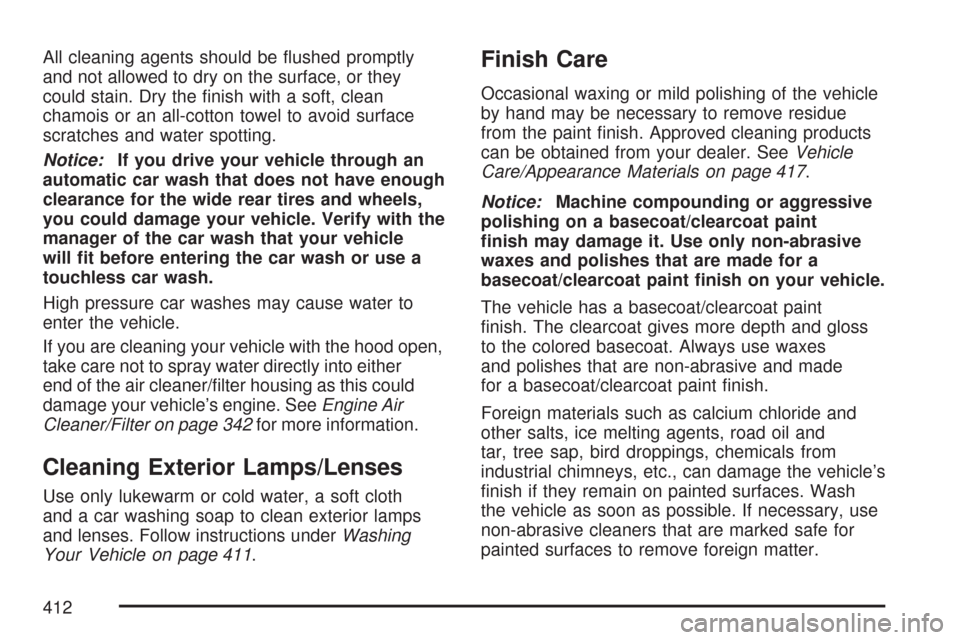Page 353 of 488
Cooling System
When you decide it is safe to lift the hood,
here is what you will see:
A. Electric Engine Cooling Fan
B. Coolant Surge Tank with Pressure Cap{CAUTION:
An electric engine cooling fan under the
hood can start up even when the engine
is not running and can injure you. Keep
hands, clothing, and tools away from
any underhood electric fan.
If the coolant inside the coolant surge tank is
boiling, do not do anything else until it cools down.
The vehicle should be parked on a level surface.
353
Page 355 of 488

the coolant surge tank, but be sure the cooling
system, including the coolant surge tank pressure
cap, is cool before you do it. SeeEngine
Coolant on page 347for more information.
If no coolant is visible in the surge tank, add
coolant as follows:
{CAUTION:
Steam and scalding liquids from a hot
cooling system can blow out and burn
you badly. They are under pressure, and if
you turn the coolant surge tank pressure
cap — even a little — they can come out
at high speed. Never turn the cap when
the cooling system, including the coolant
surge tank pressure cap, is hot. Wait
for the cooling system and coolant
surge tank pressure cap to cool if you
ever have to turn the pressure cap.
{CAUTION:
Adding only plain water to your cooling
system can be dangerous. Plain water, or
some other liquid such as alcohol, can
boil before the proper coolant mixture will.
Your vehicle’s coolant warning system is
set for the proper coolant mixture. With
plain water or the wrong mixture, your
engine could get too hot but you would
not get the overheat warning. Your engine
could catch �re and you or others could
be burned. Use a 50/50 mixture of clean,
drinkable water and DEX-COOL
®coolant.
Notice:In cold weather, water can freeze and
crack the engine, radiator, heater core and
other parts. Use the recommended coolant
and the proper coolant mixture.
355
Page 362 of 488

Checking Brake Fluid
You can check the brake �uid without taking
off the cap. Look at the brake �uid reservoir.
The �uid level should be above the MIN mark on
the reservoir. If it is not, have the brake system
checked to see if there is a leak.
After work is done on the brake hydraulic system,
make sure the level is between the MIN and
MAX marks.
What to Add
When you do need brake �uid, use only DOT-3
brake �uid. Refer toRecommended Fluids
and Lubricants on page 443. Use new brake
�uid from a sealed container only.
Always clean the brake �uid reservoir cap and
the area around the cap before removing it. This
will help keep dirt from entering the reservoir.
{CAUTION:
With the wrong kind of �uid in the brake
system, the brakes may not work well.
This could cause a crash. Always use the
proper brake �uid.
Notice:
Using the wrong �uid can badly damage
brake system parts. For example, just a
few drops of mineral-based oil, such
as engine oil, in the brake system can
damage brake system parts so badly that
they will have to be replaced. Do not
let someone put in the wrong kind of �uid.
If you spill brake �uid on your vehicle’s
painted surfaces, the paint �nish can
be damaged. Be careful not to spill brake
�uid on your vehicle. If you do, wash it
off immediately. SeeWashing Your Vehicle
on page 411.
362
Page 366 of 488

Notice:If you leave your radio or other
accessories on during the jump starting
procedure, they could be damaged. The
repairs would not be covered by your
warranty. Always turn off your radio and
other accessories when jump starting
your vehicle.
3. Turn off the ignition on both vehicles. Unplug
unnecessary accessories plugged into the
cigarette lighter or the accessory power outlet.
Turn off the radio and all lamps that are not
needed. This will avoid sparks and help save
both batteries. And it could save the radio!
4. Open the hoods and locate the positive (+) and
negative (−) terminal locations on each vehicle.Your vehicle has a remote positive (+)
terminal (A) and a remote negative (−)
terminal (B), as shown in the illustration, which
should be used to jump start your vehicle.
The remote positive (+) terminal (A) can
be accessed by opening the cover of the
engine compartment fuse block.
The remote negative (−) terminal (B) is
located underneath the engine cover,
below the engine oil �ll cap.
366
Page 367 of 488

SeeEngine Compartment Overview on
page 330for the location of the engine
compartment fuse block and engine oil �ll cap.
You will not need to access the battery for
jump starting. The remote terminals are
for that purpose.
{CAUTION:
An electric fan can start up even when the
engine is not running and can injure you.
Keep hands, clothing and tools away from
any underhood electric fan.
{CAUTION:
Using a match near a battery can cause
battery gas to explode. People have
been hurt doing this, and some have
been blinded. Use a �ashlight if you
need more light.
CAUTION: (Continued)
CAUTION: (Continued)
Be sure the battery has enough water.
You do not need to add water to the
battery installed in your new vehicle.
But if a battery has �ller caps, be sure the
right amount of �uid is there. If it is low,
add water to take care of that �rst. If you
do not, explosive gas could be present.
Battery �uid contains acid that can
burn you. Do not get it on you. If you
accidentally get it in your eyes or on
your skin, �ush the place with water
and get medical help immediately.
{CAUTION:
Fans or other moving engine parts can
injure you badly. Keep your hands away
from moving parts once the engine is
running.
367
Page 412 of 488

All cleaning agents should be �ushed promptly
and not allowed to dry on the surface, or they
could stain. Dry the �nish with a soft, clean
chamois or an all-cotton towel to avoid surface
scratches and water spotting.
Notice:If you drive your vehicle through an
automatic car wash that does not have enough
clearance for the wide rear tires and wheels,
you could damage your vehicle. Verify with the
manager of the car wash that your vehicle
will �t before entering the car wash or use a
touchless car wash.
High pressure car washes may cause water to
enter the vehicle.
If you are cleaning your vehicle with the hood open,
take care not to spray water directly into either
end of the air cleaner/�lter housing as this could
damage your vehicle’s engine. SeeEngine Air
Cleaner/Filter on page 342for more information.
Cleaning Exterior Lamps/Lenses
Use only lukewarm or cold water, a soft cloth
and a car washing soap to clean exterior lamps
and lenses. Follow instructions underWashing
Your Vehicle on page 411.
Finish Care
Occasional waxing or mild polishing of the vehicle
by hand may be necessary to remove residue
from the paint �nish. Approved cleaning products
can be obtained from your dealer. SeeVehicle
Care/Appearance Materials on page 417.
Notice:Machine compounding or aggressive
polishing on a basecoat/clearcoat paint
�nish may damage it. Use only non-abrasive
waxes and polishes that are made for a
basecoat/clearcoat paint �nish on your vehicle.
The vehicle has a basecoat/clearcoat paint
�nish. The clearcoat gives more depth and gloss
to the colored basecoat. Always use waxes
and polishes that are non-abrasive and made
for a basecoat/clearcoat paint �nish.
Foreign materials such as calcium chloride and
other salts, ice melting agents, road oil and
tar, tree sap, bird droppings, chemicals from
industrial chimneys, etc., can damage the vehicle’s
�nish if they remain on painted surfaces. Wash
the vehicle as soon as possible. If necessary, use
non-abrasive cleaners that are marked safe for
painted surfaces to remove foreign matter.
412
Page 426 of 488
Capacities and Speci�cations
The following approximate capacities are given in English and metric conversions.
SeeRecommended Fluids and Lubricants on page 443for more information.
ApplicationCapacities
English Metric
Air Conditioning Refrigerant R134aFor the air conditioning system refrigerant
charge amount, see the refrigerant
caution label located under the hood.
See your dealer for more information.
Cooling System 12.6 qt 11.9 L
Engine Oil with Filter
6.0 L V8 Engine 5.5 qt 5.2 L
6.0 L V8 Engine Performance Package (Z51) 6.0 qt 5.7 L
7.0 L V8 Engine 8.0 qt 7.6 L
Fuel Tank 18.0 gal 68.0 L
Transmission Fluid
Automatic Transmission
(Pan Removal and Filter Replacement)6.5 qt 6.2 L
Manual Transmission – Base 3.6 qt 3.5 L
426
Page 430 of 488
Maintenance Schedule
Introduction
Important: Keep engine oil at the proper level
and change as recommended.
Have you purchased the GM Protection Plan? The
Plan supplements your new vehicle warranties.
See your Warranty and Owner Assistance booklet
or your dealer for details.
Maintenance Requirements
Notice:Maintenance intervals, checks,
inspections, replacement parts, and
recommended �uids and lubricants as
prescribed in this manual are necessary to
keep your vehicle in good working condition.
Any damage caused by failure to follow
scheduled maintenance might not be covered
by warranty.
430